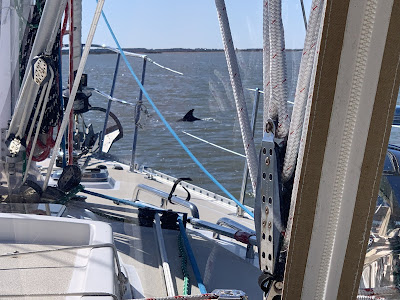Monday, November 2, 2020
Yesterday early evening was peaceful and quiet snugged in along the Awendaw Creek, surrounded by marsh grass and an occasional hillock with scrub trees. Just after sunset I was startled to hear air escaping from somewhere and hurried to check out our inflatable dinghy for fear it had sprung a leak. What a surprise to realize I had heard two dolphins as I spied them heading back to the Atlantic’s open water!
We have seen dolphins many times on the trip so far. We are most likely to see them near inlets where creeks and rivers run out to the ocean, especially when the tide is turning. Of course, that’s also when shoaling is most likely to occur along the ICW channel, requiring both of us to be hyper-vigilant of our course. So I almost always miss photo ops of the elusive dolphins. Growing up watching Flipper and Sea Hunt has forever endeared me to these friendly creatures. (I was successful earlier in the day.)
We’ve had a chance to observe some other animal behaviors along the way. For instance, gulls and terns, like the dolphins, are most abundant around the inlets and where rivers and creeks converge. It’s quite an acrobatic act as they seize the opportunity and swoop in for a tasty meal by dive-bombing the churned up foamy water caused by every overtaking motor vessel’s wake.
But back to the anchorage at Awendaw Creek. As I wrote above, it was peaceful and calm.
Until it wasn’t. We knew a blow was coming (by now you realize that we obsessively pour over weather forecasts each night). We had already lashed down the sail cover over the main, checked all our hatches and rigging and deployed extra anchor chain. Back in Boston in the winter, David had shown me videos of boats at anchor during ferocious storms, bouncing up and down and chafing their “ground tackle” to the point of breaking. He convinced me that it would be prudent to purchase an additional storm “bridle.” I’m glad he did.
When we set anchor, we also deploy an amount of chain “rode” appropriate for the depth of the spot we’re in and the predicted wind and current conditions, anywhere from a 5:1 to a 7:1 ratio of amount of rode to the depth (from the topsides of the boat). So if high tide is going to be 10’ and the distance from the water to the top of our anchor roller is 4’ then we need to deploy somewhere between 5x14 and 7x14 feet of chain. In addition, David deployed the storm “bridle” which acts to absorb the stress and strain on the bow roller and the windlass (the electric winch that brings the chain and anchor up and down.)
When the cold front came through from 1:30 to 3:40 a.m.on Monday morning, we felt it. The wind howled, the boat strained and groaned, the rigging vibrated, we swung on the anchor and rocked and rolled from the power of 30+ knot gusts. But the anchor and ground tackle held and once the winds subsided slightly, we slept well. It was still gusting in the 20’s when we weighed anchor in the morning but we got on our way safely.
Our Monday passage continued with wide, scenic marsh views to the east and alternating marsh and forested land to the west as we passed through the Cape Romain National Wildlife Refuge and the Francis Marion National Forest. We are all incredibly indebted to those who had the foresight and passion to work to preserve invaluable natural habitats.
Finally, we followed a long land cut before reaching storied Charleston Harbor.



No comments:
Post a Comment